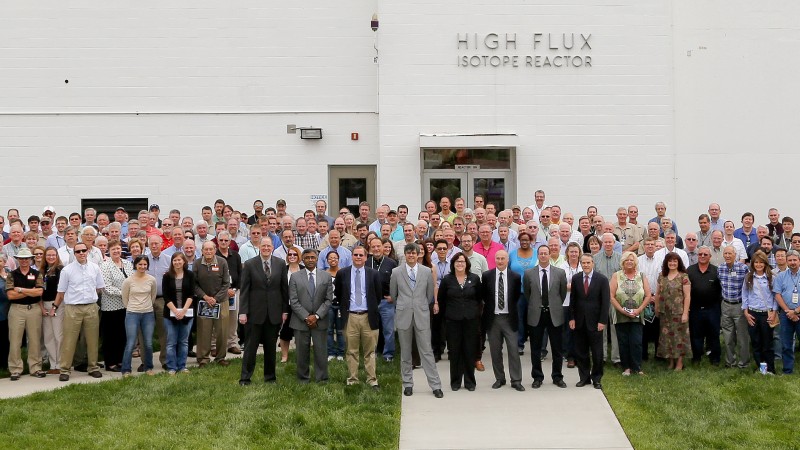The High Flux Isotope Reactor marked its 50th year and its designation as an American Nuclear Society Nuclear Historic Landmark on Monday, April 13, at the HFIR complex. HFIR staff and guests, including retirees and ANS President Michaele C. Brady Raap, assembled in the meeting hall in Bldg. 7995. The day's program also included a group photo in front of the HFIR building, staff tours in the afternoon and a seminar by the Chemical Sciences Division's David Glasgow.
Science & Technology Partnerships Director Jim Roberto presented a history of the research reactor, which was conceived as a response by calls, including by then Atomic Energy Commission Chairman Glenn Seaborg, for a more powerful source of radioisotopes. The 1958 design of a flux-trap reactor from an Oak Ridge School of Reactor Technology project led by Dick Cheverton was well timed, in a Cold War setting, with the Soviet Union's announced plans for a similar reactor.
Originally designed for radioisotope production and materials irradiation, beam tubes were included at the insistence of then-Lab Director Alvin Weinberg. The addition proved prescient as neutron scattering eventually became the dominant of the three chief HFIR missions. Jim recounted highlights of the half-century, which include Ralph Moon's invention of neutron polarization analysis in 1969, the development of small-angle neutron scattering by George Wignall and Wally Koehler in 1978, Herb Mook's high-temperature superconductivity research in the early 1990s, the 2007 refurbishment that added the invaluable cold-source capability that's also marking its 50th fuel cycle, and HFIR's 2010 role in the element 117 discovery.
Lab Director Thom Mason recognized Don Asquith, an instrumentation and controls engineer who has been with the project from the beginning. Site Office Manager Johnny Moore noted the excellence and forethought in the reactor's original design, accomplished in the days of slide rules.
Research Reactors Division Director Tim Powers closed with a challenge to match or exceed HFIR's record of achievement going forward. "I believe in my heart of hearts that she's got 50 more years," he said. "Our greatest research is ahead of us."
+ View the group photo: https://www.flickr.com/photos/ornl-neutronsciences/17150687005/
+ View additional photos from the event: https://www.flickr.com/photos/ornl-neutronsciences/sets/72157651723529849
+ Download the HFIR history presentation by Jim Roberto: Download the ppt file (45MB)
+ Download the HFIR celebration program: Download the pdf file (11MB)
+ Download the HFIR celebration poster: Download the pdf file (3 MB)




